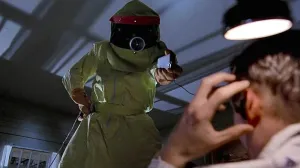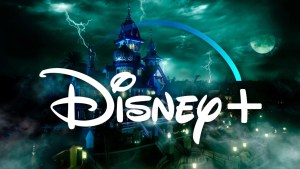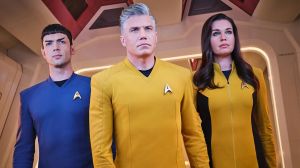We’ve said it before and we’ll say it again: 2016 was a great year for comics. It seemed that no matter where you looked, at any variety of publishers, genres, or creators, everyone was seeking to top themselves and one another. Looking at what was released throughout the world of comics in 2016, it’s nothing short of an embarrassment of riches.
Videos by ComicBook.com
Now comes the difficult take of narrowing it down and selecting the absolute best of the best to recommend to readers looking to catch up. Just like in 2014 and 2015, comics critic Chase Magnett has selected the 20 best comics of 2016. This list pulls from mainstream fare, manga, indie publishing, and everything in between. It’s a diverse compilation of all that the comics medium has to offer. We hope you enjoy it and find a few more great reads to end this year with.
So without any further ado, here is part two, collecting our #10-1 selections for 2016:

10. Hot Dog Taste Test
Created by Lisa Hanawalt
Published by Drawn & Quarterly
Lisa Hanawalt’s brief visual essays, observations, and gags come together in a volume that provides ample laughter between brief moments of idiosyncratic insight. The use of food as a shared societal connective tissue takes turn in appetizing and horrifying based on the feeling of any given page. Hot Dog Taste Test reads like stream of consciousness cartooning, offering unexpected insight into a stranger’s mind and making our own thoughts seem a little more normal in their strangeness.

9. Saga
Created by Brian K. Vaughan (writer) and Fiona Staples (artist)
Published by Image Comics
Saga is a mainstay in discussions of quality comics for a good reason. The craft of Vaughan and Staples as a collaborative team is almost without peer and they deliver the same high standard of quality together even after 40 issues. What keeps Saga relevant though is the combination of timeless themes of family with the observation and specifically crafted metaphors for modern fears. In addressing refugee crises and imprisonment within their own universe, this pair has ensured Saga will remain relevant even as its characters have become familiar in every comics-loving household.

8. A Girl On The Shore
Created by Inio Asano
Published by Vertical Comics
Sexual maturation in adolescence is a difficult subject to tackle in any form, but especially comics. That makes Inio Asano’s accomplishments in A Girl On The Shore all the more impressive. His typically stunning attention to detail helps craft a delicate and precise portrait of two teenagers and their complex internal lives in a relationship where so much often remains unspoken. It is a well-observed and perfectly realistic depiction of the unique humanity that lies within all of us, no matter our age or experiences.

7. Rolling Blackouts
Created by Sarah Glidden
Published by Drawn & Quarterly
Questions surrounding the nature of journalism are more important than ever today, and one of the best explorations of this complex subject has arrived in comics form. Glidden’s account of travels to the Middle East with several other journalists provide both insight into modern conflicts and the struggles faced in reporting on them. It is the rare sort of modern story that will prove to be timeless, as the depictions on the page and philosophical issues raised will remain poignant for decades after these moments have passed.

6. COPRA
Created by Michel Fiffe
Published by Bergen Street Press
In a year where everyone wanted to talk about the decades old property of Suicide Squad, COPRA continued to impress by pushing into new territory. Within the pages of Michel Fiffe’s ongoing opus the exploration of aesthetic, action storytelling, and peculiar worlds was as unique as ever. Yet within the special 25th issue and spinoff series COPRA Versus, he devised new ways to compose pages and relate stories. The beauty of COPRA continues to be a celebration of invention, taking inspiration and transforming it into something previously unimagined.

5. Demon
Created by Jason Shiga
Published by First Second
Demon reached its conclusion online and found a second life in the first of four planned volumes at First Second. Whether you’re finishing or starting the story in 2016, it’s a clear testament to exacting and thorough genius of Jason Shiga. Taking the stories incredibly twisted and darkly humorous premise (one best left unspoiled), Shiga carefully walks through the implications and strategies of his central character. Demon is a comic that will gross you out, make you laugh, and surprise you with its intelligence, often in the same panel.

4. The Vision
Created by Tom King (Writer), Gabriel Hernandez Walta (Artist), Michael Walsh (Artist), and Jordie Bellaire (Colorist)
Published by Marvel Comics
Tom King’s “Trilogy of Good Intentions” was a highlight for 2016, but The Vision stands out from the rest for its incredible combination of superhero genre elements and the quiet suburban tragedy of a Jonathan Franzen story. Each issue built a complete family along with a sense of mounting dread. Now complete and taken as a whole it stands as a novelistic examination upon questions of life, happiness, and the ability to change. Utilizing both Shakespeare and Spider-Man, King and Walta crafted a story that is greater than the many and varied pieces that make up its whole.

3. The Art of Charlie Chan Hock Chye
Created by Sonny Liew
Published by Pantheon Graphic Novels
It’s rare that a work as complete and densely layered as The Art of Charlie Chan Hock Chye come along in any medium. The formalistic leanings, layers of art history, actual historical foundations, and broader philosophical questions all lend themselves to a construct as thoroughly crafted and endlessly examinable as Watchmen. Sonny Liew’s comic is a testament to the potential of the comics form and will surely be studied and taught in English and art classes alike for its incredible accomplishments.

2. March: Book Three
Created by Rep. John Lewis (writer), Andrew Aydin (writer), and Nate Powell (artist)
Published by Top Shelf Productions
The climax of this historical narrative manages to exceed the expectations of the previous two installments in the trilogy both narratively and artistically. The largest of the three volumes by far, March: Book Three not only examines the historical narrative of the Civil Rights Movement, but the inevitable cracks and flaws that form within any good cause. It speaks to both the long arc of the moral universe towards justice while acknowledging the slow and steady march required to reach that point. March is not just a commentary on history, but a vital affirmation and reminder to continue fighting for justice today.

1. Goodnight Punpun
Created by Inio Asano
Published by VIZ Media
Inio Asano has been an undeniable force within manga for some years and in 2016 he truly arrived on the American comics scene. In addition to A Girl On The Shore, this year also saw the first official translations of Asano’s magnum opus Goodnight Punpun. It is a story of growing up and how we arrive at the answers of who we are and how we define ourselves. Asano challenges himself and readers by juxtaposing the cartoonish Punpun against his perfectly constructed depictions of Japanese settings and people. The combination of these two styles create a statement that is incredibly potent as metaphor and aesthetic statement. It is a work that manages to be intensely personal and surprisingly universal. For all of these reasons and more, Goodnight Punpun stands out as a truly singular artistic achievement, one that already belongs in the comics canon.
That’s all for this year’s best comics list. Be sure to share your own favorites from 2016 in the comments below.
_________________________________________________________________
A Brief Note on Accreditation: Many of the comics on this list are a collaborative effort featuring the work of writers, pencillers, inkers, colorists, letterers, designers, and many others. Rather than feature a comprehensive list of all creators involved in the creation of each comic, I have opted to include only the names of the artists, writers, and colorists most associated with the work. Roles are denoted in parentheses as specified in the work. This is not meant to demean the work of the others involved. It is a decision made due to concern for space.








